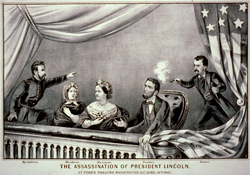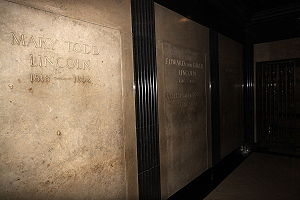Mary Todd Lincoln
This article needs additional citations for verification. (August 2007) |
Mary Todd Lincoln | |
|---|---|
| File:MTLincoln.jpg Mary Todd Lincoln, about 1846 | |
| 20th First Lady of the United States | |
| In office March 4, 1861 – April 15, 1865 | |
| Preceded by | Harriet Lane |
| Succeeded by | Eliza McCardle Johnson |
| Personal details | |
| Born | December 13, 1818 Lexington, Kentucky, U.S. |
| Died | July 16, 1882 (aged 63) Springfield, Illinois, U.S. |
| Spouse | Abraham Lincoln |
| Children | Eddie Lincoln, Robert Todd Lincoln, Willie Lincoln, Tad Lincoln |
| Occupation | First Lady of the United States |
Mary Ann Todd Lincoln (December 13, 1818–July 16, 1882) was the wife of the 16th President of the United States, Abraham Lincoln, and was First Lady of the United States from 1861 to 1865.
Life Before the White House
Born in Lexington, Kentucky, the daughter of Robert Smith Todd, a banker, and Elizabeth Parker-Todd, Mary was raised in comfort and refinement. After her mother's death at age seven, her father remarried Elizabeth "Betsy" Humphreys-Todd in 1826. [1] Mary had a difficult relationship with her stepmother. Beginning in 1832, Mary's childhood home was what is now known as the Mary Todd Lincoln House, a 14-room upper-class residence in Lexington. [2] From her father's marriages to her mother and stepmother, she had 15 siblings.
Mary Todd attended fine schools, spoke French fluently, and studied dance, drama and music. She had a ready wit and sparking personality that made her quite popular. She had an explosive temper and a quarrelsome nature, however, and was mentally unstable. She suffered from agonizing migraine headaches. Some recent historians and physicians have suggested that she suffered from schizophrenia, and her name often appears on lists of famous persons with schizophrenia.[3][4] However, such a diagnosis would have been impossible in her lifetime, and any diagnosis at this late date cannot be certain.
At the age of twenty, in 1839, Mary Todd left the family home and moved to Springfield, Illinois, where her sister Mrs. Elizabeth Edwards was already living.[5] Although Mary was courted by the rising young lawyer and politician Stephen A. Douglas, she was unexpectedly attracted by Douglas's lower-status rival, and fellow lawyer, Abraham Lincoln. Elizabeth facilitated their courtship and introduced Mary to Abraham at a dance on December 16.
After a hesitant two-year courtship, Abraham Lincoln, age 33, married Mary Todd, age 23, on November 4, 1842, at the home of Mrs. Elizabeth Edwards in Springfield, Illinois. The Lincolns apparently had a comfortable marriage before the pressures of public life began to threaten her fragile mind. She became paranoid and irrationally jealous of those around the president. Abraham pursued his increasingly successful career as a Springfield lawyer, and Mary supervised their growing household. Their home together from 1844 until 1861 survives in Springfield, and is now the Lincoln Home National Historic Site.
Their children, all born in Springfield, were:
- Robert Todd Lincoln (1843-1926) - lawyer, diplomat, businessman.
- Edward Baker Lincoln known as "Eddie" (1846-1850)
- William Wallace Lincoln known as "Willie" (1850-1862)
- Thomas Lincoln known as "Tad" (1853-1871)
By all accounts, both Mr. and Mrs. Lincoln were indulgent, careful, kind, and loving parents. Of these four sons, only Robert and Tad survived into adulthood, and only Robert outlived his mother.
While she often resented her husband's absence from their home as he practiced law and campaigned for political office, Mrs. Lincoln staunchly supported him as he faced the growing crisis caused by American slavery. This concluded in Lincoln's election as President of the United States.
Lincoln's election caused eleven Southern states to secede from the Union. Anti-Union sentiment was very strong in Mrs. Lincoln's home state of Kentucky, one of the four slave states that did not secede. Many upper-class Kentuckians who were members of the social stratum into which Mrs. Lincoln had been born, supported the Southern cause.
Assassination Survivor and later Life

In April 1865, as the Civil War came to an end, Mrs. Lincoln hoped to renew her happiness as the First Lady of a nation at peace. However, on April 14, 1865, as Mary Lincoln sat with her husband to watch the comic play Our American Cousin at Ford's Theatre, President Lincoln was mortally wounded by an assassin. Mrs. Lincoln accompanied her husband across the street to the Petersen House, where the President died on the following day, April 15. Mary Lincoln would never fully recover from the traumatic experience; she became even more unhinged.
As a widow, Mrs. Lincoln returned to Illinois. In 1868, Mrs. Lincoln's former confidante, Elizabeth Keckly, published Behind the Scenes, or, Thirty years a slave, and four years in the White House. Although this book has, over time, proved to be an extremely valuable resource in the understanding and appreciation of Mary Todd Lincoln, the former First Lady regarded it as a breach of what she had considered to be a close friendship. Mrs. Lincoln was further isolated, and often railed against "Slick Lizzie" in her later years.
In an act approved July 14, 1870, the United States Congress granted Mrs. Lincoln a life pension for being the widow of President Lincoln, in the amount of $3,000 a year.[6]
For Mary Lincoln, the death of her son Thomas (Tad), in July 1871, led to an overpowering sense of grief and the gradual onset of depression. Mrs. Lincoln's sole surviving son, Robert Lincoln, a rising young Chicago lawyer, was alarmed by his mother's free spending of money; she began hallucinating and spoke of plots to have her murdered. Mary Lincoln was prescribed laudanum for sleep problems which caused her to suffer anxiety and hallucinations. Upon increase of these hallucinations, more laudanum and chloral hydrate was administered, which increased the problem and led to her eventual commitment to a mental institution. In 1875, Mary Lincoln was committed by an Illinois court to Bellevue Place in Batavia, Illinois. After three months, she was released into the custody of her sister, Mrs. Elizabeth Edwards in Springfield and in 1876 was once again declared competent to manage her own affairs.
Mrs. Lincoln spent the next four years abroad taking up residence in Pau, France. She spent much of this time travelling in Europe. However, the former First Lady's final years were marked by declining health. She suffered from severe cataracts that affected her eyesight. This may have contributed to her increasing susceptibility to falls. In 1879, she suffered spinal cord injuries in a fall from a step ladder.
Death

During the early 1880s, Mary Todd Lincoln lived, housebound, in the Springfield, Illinois residence of her sister Elizabeth Edwards. She died there on July 16, 1882, age 63, and was interred within the Lincoln Tomb in Oak Ridge Cemetery in Springfield along with her husband.
Trivia
This article contains a list of miscellaneous information. (August 2007) |
This section needs additional citations for verification. (February 2008) |
- Her great uncle John Todd was killed in the last battle of the American Revolution-the Battle of Blue Licks.
- Her sister Elizabeth Todd was the daughter-in-law of Illinois Governor Ninian Edwards. Elizabeth's daughter Julia Edwards married Edward L. Baker, editor of the "Illinois State Journal" and son of Congressman David Jewett Baker.
- Her half sister Emilie Todd married CS General Benjamin Hardin Helm, son of Kentucky Governor John L. Helm. Governor Helm's wife was a 1st cousin 3 times removed of Colonel John Hardin who was related to three Kentucky congressman.
- A cousin was Kentucky Congressman/US General John Blair Smith Todd.
- Another cousin, William L. Todd,[7] created the original Bear Flag for the California Republic in 1846.
- Cello-punk band Rasputina's concept album Oh Perilous World features an alternative-history scenario where Mary Todd Lincoln is Queen of Florida.
- Singer/songwriter Sufjan Stevens included an instrumental on his album Illinois entitled "A Short Reprise for Mary Todd, Who Went Insane, but for Very Good Reasons".
- In Andrew Holleran's historical novella Grief: a Novel, the main protagonist reflects on Mary Todd Lincoln's letters and comes to deal with his loss through Lincoln's elegiac writing.
- Lincoln was the subject of one of William H. Mumler's most famous spirit photographs, apparently sitting with the ghost of her husband.[8]
- John Hay, an aide to President Lincoln, privately referred to Mary as "the hellcat."
See also
References
- ^ Mary Todd Biography
- ^ Mary Todd Lincoln House
- ^ Famous People with Schizophrenia from schizophrenia.com. Accessed December 12, 2008.
- ^ Diagnosis of schizophrenia by John Bromley Moses, MD. Accessed December 12, 2008.
- ^ Mary Todd Lincoln biography
- ^ Acts of 1870, Chapter 277
- ^ Mary Todd GenealogySee Generation 5, Child "C" Grandchild 3 for William L (WLT), Generation 5 Child "G" = Generation 6 (grand) Child D for Mary (MATL) Shorthand Common Ancestor 5 WLT = 5C3, MATL= 5G4 = 6D = 7. 5C & 5G are brothers, which makes their children first cousins. The Revolutionary William is generation 3 child "I" The MATL/WLT line follows 3B to 4D to 5'
- ^ Willin, Melvyn. "The Earliest Images". Ghosts Caught on Film: Photographs of the Paranormal. West, Donald. Newton Abbot: David & Charles. p. 22. ISBN 9780715327289.
External links
- Photographs of Mary Todd Lincoln
- Mary Todd Lincoln House (National Park Service)
- Mary Todd Lincoln House (Official Home Page)
- Mary Todd Lincoln Research Site
- Mary Todd Lincoln in 1862 Harper's Weekly Newspaper
- Especially for students - An Overview of Mary Todd Lincoln's Life
- Mr. Lincoln's White House: Mary Todd Lincoln
- "Wet with Blood," Research Project on Mary Todd Lincoln's Cloak, Chicago History Museum (formerly Chicago Historical Society)
- Collection of Mary Todd Lincoln Letters
- Articles with trivia sections from August 2007
- 1818 births
- 1882 deaths
- Abraham Lincoln
- First Ladies of the United States
- Lexington in the American Civil War
- Lincoln family
- People from Lexington, Kentucky
- People from Springfield, Illinois
- People of Kentucky in the American Civil War
- Spouses of members of the United States House of Representatives
- Women in the American Civil War
